
|
Great outburst occured on Oct. 24, 2007, and it bacame a naked eye comet of 2 mag. It kept so bright as 5.5 mag still on Apr. 30 (Carlos Labordena), but it was extremely faint and difficult to see. The size was so large, the diameter was larger than 60 arcmin. It will become observable in good condition in autumn again. The extremely faint large diffuse object may be detected with a best sky condition, around 5-6 mag with a diameter of 1 or 2 degrees. Now the nuclear brightness is 18.5 mag (Oct. 2, Francois Kugel). The coma and tail around the nucleus looks bright, and the total magnitude of the central part may be around 15 mag. Maybe visible visually with a large telescope.
Date(TT) R.A. (2000) Decl. Delta r Elong. m1 Best Time(A, h)
Oct. 11 9 3.22 26 28.7 4.149 3.882 67 6.0 3:55 (229, 8)
Oct. 18 9 8.10 26 10.1 4.073 3.907 73 6.0 3:45 (228, 10)
|
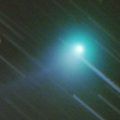
|
It reached to 6.3 mag in September in the southern sky (Sept. 4, Marco Goiato). Now it is still bright as 7.3 mag (Oct. 2, Marco Goiato). It became observable in the evening low sky also in the Northern Hemisphere. It keeps locating in the evening low sky until the end of 2008 when it fades out down to 10 mag. Then it turns to appear in the morning sky, and it keeps observable in the northern sky after that while fading gradually. In the Southern Hemisphere, it is only observable until late October.
Date(TT) R.A. (2000) Decl. Delta r Elong. m1 Best Time(A, h)
Oct. 11 15 54.12 -18 5.1 1.597 1.091 42 6.9 19:38 ( 83, 21)
Oct. 18 16 14.60 -13 33.5 1.680 1.117 39 7.1 19:45 ( 85, 16)
|
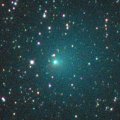
|
Now it is 8.5 mag (Sept. 24, Juan Jose Gonzalez). Now it is brightest, expanding the large coma. It keeps bright as 9 ma until late October. In the Northern Hemisphere, it keeps observable until it fades out. Although it locates extremely low now, it will be getting higher slowly after this.
Date(TT) R.A. (2000) Decl. Delta r Elong. m1 Best Time(A, h)
Oct. 11 22 31.81 -38 39.0 0.712 1.502 121 8.7 21:11 ( 0, 86)
Oct. 18 22 47.58 -37 37.8 0.782 1.537 119 8.9 20:59 ( 0, 88)
|
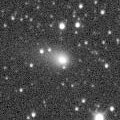
|
Now it is 9.4 mag (Oct. 2, Marco Goiato). It is expected to reach to 4 mag in 2009 February. Getting lower in the evening sky. It will be unobservable temporarily in November, but it will appear in the morning sky again at 7 mag in late December. Then it keeps observable in the excellent condition long time around the highlight until spring.
Date(TT) R.A. (2000) Decl. Delta r Elong. m1 Best Time(A, h)
Oct. 11 16 25.79 -20 28.8 2.302 1.829 50 9.4 19:38 ( 84, 29)
Oct. 18 16 21.65 -20 22.1 2.363 1.757 42 9.2 19:45 ( 79, 21)
|
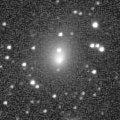
|
Brightening very rapidly, faster than expected. It is already so bright as 10.8 mag (Oct. 4, Seiichi Yoshida). Strongly condensed and easy to see. It is expected to reach to 8 mag in 2009 summer. Because it moves in the northern sky, it keeps observable until it becomes brightest in the Northern Hemisphere.
Date(TT) R.A. (2000) Decl. Delta r Elong. m1 Best Time(A, h)
Oct. 11 0 29.63 76 2.0 3.570 4.034 110 10.9 23:04 (180,-21)
Oct. 18 23 45.58 74 42.0 3.496 3.994 113 10.7 21:53 (180,-20)
|
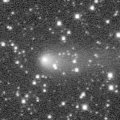
|
Now it is bright as 11.3 mag (Oct. 4, Seiichi Yoshida). It keeps observable in good conditioni as bright as 11 mag from autumn to winter. It keeps observable, visible visually, brighter than 14 mag for a long time until 2009 May.
Date(TT) R.A. (2000) Decl. Delta r Elong. m1 Best Time(A, h)
Oct. 11 6 14.51 59 18.9 2.027 2.447 102 10.8 3:55 (188, -5)
Oct. 18 6 25.75 59 53.2 1.980 2.457 106 10.8 3:45 (187, -6)
|

|
It is expected to reach up to 7 mag in winter, and will be observable in good condition. However, this comet has not been observed since 1986. It is predicted to be brightening up to around 11-12 mag, bright enough to be recovered. However, it was not detected, fainter than 20 mag on Sept. 26 (Gustavo Muler). It seems much fainter than expected. The condition of this apparition is good. It keeps observable for a long time until 2009 early summer both in the Northern Hemisphere and Southern Hemisphere. Maybe it can brighten very rapidly near by the perihelion.
Date(TT) R.A. (2000) Decl. Delta r Elong. m1 Best Time(A, h)
Oct. 11 19 47.17 -21 51.3 0.960 1.465 96 11.5 19:38 (125, 69)
Oct. 18 19 56.96 -20 52.3 0.958 1.410 92 10.9 19:45 (117, 64)
|
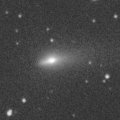
|
Now it is 10.8 mag (Sept. 29, Juan Jose Gonzalez). It keeps observable and fading in the morning sky after this. It keeps brighter than 14 mag and visible visually until the end of 2008. In the Southern Hemisphere, it keeps extremely low, or under the horizon, so it will not be observable.
Date(TT) R.A. (2000) Decl. Delta r Elong. m1 Best Time(A, h)
Oct. 11 10 36.97 27 43.3 2.086 1.635 50 11.4 3:55 (242, -8)
Oct. 18 10 57.16 27 25.3 2.082 1.678 52 11.7 3:45 (243, -9)
|
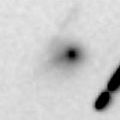
|
An outburst occured in late May and it brightened up to 14.6 mag (May 23, Gustavo Muler), but it faded down to the original brightness in late May. Then it had been reported so faint as 17 mag by CCD observations. However, it suddenly became so bright and visible visually after late August. Now it is so bright as 11.0 mag visually (Sept. 24, Juan Jose Gonzalez). Much brighter than originally predicted, by 3 mag. However, the nuclear magnitude by CCD is so faint as 16.6 mag (Sept. 9, Yasukazu Ikari). It locates extremely low in the Northern Hemisphere.
Date(TT) R.A. (2000) Decl. Delta r Elong. m1 Best Time(A, h)
Oct. 11 16 5.71 -22 17.3 1.739 1.265 45 11.8 19:38 ( 80, 26)
Oct. 18 16 32.14 -25 0.8 1.766 1.280 45 12.1 19:45 ( 76, 26)
|
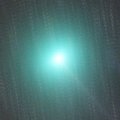
|
It became so bright as 4.7 mag, and so large as 20 arcmin in June (June 12, Marco Goiato). Now it is fading. But it is still visible visually at 12.4 mag (Oct. 4, Seiichi Yoshida). It keeps observable in good condition for a long time after this. Although it is extremely diffuse now, it will be visible visually for some more time in the excellent sky condition.
Date(TT) R.A. (2000) Decl. Delta r Elong. m1 Best Time(A, h)
Oct. 11 0 52.80 20 43.8 1.009 1.992 165 12.1 23:30 (180, 34)
Oct. 18 0 44.10 19 40.7 1.106 2.083 164 12.5 22:54 (180, 35)
|
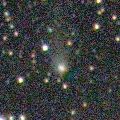
|
Now it is bright as 11.5 mag (Aug. 4, Marco Goiato). It keeps bright at 12 mag for a long time from 2008 spring to 2009 spring. However, it is not observable in the Northern Hemisphere. It will appear in the northern sky again in 2009 autumn, but it will be fainter than 15 mag and will keep locating very low after that. In the Southern Hemisphere, it keeps observable for a long time until it fades out, although it becomes low in autumn.
Date(TT) R.A. (2000) Decl. Delta r Elong. m1 Best Time(A, h)
Oct. 11 15 30.65 -46 22.7 3.204 2.675 50 12.3 19:38 ( 52, 30)
Oct. 18 15 36.45 -47 51.4 3.254 2.665 46 12.3 19:45 ( 48, 26)
|
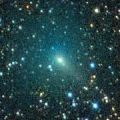
|
Diffuse comet, but it brightened up to 9.8 mag on July 7 (Juan Jose Gonzalez). Now it is fading, but still bright as 12.1 mag (Oct. 4, Seiichi Yoshida). In the Northern Hemisphere, it keeps observable until 2009 spring when the comet becomes faint. It will move near by the Northern Pole from summer to autumn, and will be observable all night. It will be visible visually for some more time. In the Southern Hemisphere, it will never be observable again.
Date(TT) R.A. (2000) Decl. Delta r Elong. m1 Best Time(A, h)
Oct. 11 12 55.48 85 37.9 1.770 2.072 92 12.3 3:55 (185,-37)
Oct. 18 12 59.61 86 48.1 1.764 2.121 96 12.6 3:45 (184,-36)
|
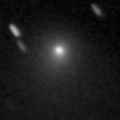
|
It reached to 10.9 mag in May (May 11, Marco Goiato). Now it is fading slowly. It has faded down to 12.0 mag on July 21 (Alexandre Amorim). Now it is not observable. In the Northern Hemisphere, it will appear in the morning sky again at 13 mag at the end of 2008, then it keeps bright and observable for a while.
Date(TT) R.A. (2000) Decl. Delta r Elong. m1 Best Time(A, h)
Oct. 11 13 42.17 -1 32.0 3.922 2.946 10 12.5 19:38 ( 77,-15)
Oct. 18 13 53.18 -1 18.9 3.948 2.971 9 12.5 19:45 ( 74,-20)
|
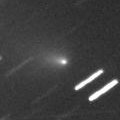
|
It had been lost for 112 years sincd 1896, but re-discovered by Koichi Itagaki and Hiroshi Kaneda on Sept. 10. It should be bright temporarily in outburst now. However, it still keeps bright as 12.6 mag (Oct. 4, Seiichi Yoshida). It keeps locating high in the evening sky for a while after this, but it can fade out rapidly.
Date(TT) R.A. (2000) Decl. Delta r Elong. m1 Best Time(A, h)
Oct. 11 21 33.38 -11 12.5 0.764 1.560 124 13.7 20:13 (180, 66)
Oct. 18 21 48.66 -12 26.0 0.819 1.577 120 14.0 20:00 (180, 67)
|

|
An large outburst occured on Sept. 21, and it became so bright as 11.3 mag (Juan Antonio Henriquez Santana). It is still bright as 10.4 mag (Oct. 4, Seiichi Yoshida). Now the diameter is 2-3 arcmin, looks very large and diffuse.
Date(TT) R.A. (2000) Decl. Delta r Elong. m1 Best Time(A, h)
Oct. 11 8 13.63 23 22.2 6.206 6.069 77 13.8 3:55 (223, 18)
Oct. 18 8 16.17 23 13.8 6.096 6.071 83 13.8 3:45 (220, 20)
|

|
Already bright as 13.5 mag, and visible visually (Oct. 7, Alan Hale). It is extremely low in the Northern Hemisphere now, but observable in good condition in the Southern Hemisphere. It is expected to brighten up to 10 mag from late 2009 to early 2010. Because the comet moves in the southern sky for a long time, it keeps impossible or very hard to observe in the Northern Hemisphere until 2009 September. But after 2009 October, it is observable at 10 mag for a while in good condition. In the Southern Hemisphere, it keeps observable for a long time while brightening until 2009 June when it brightens to 11 mag. But it becomes unobservable around and after the brightest time.
Date(TT) R.A. (2000) Decl. Delta r Elong. m1 Best Time(A, h)
Oct. 11 6 17.87 -47 32.3 4.267 4.430 92 13.9 3:55 (322, 73)
Oct. 18 6 19.76 -48 38.4 4.183 4.374 94 13.8 3:45 (330, 74)
|
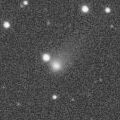
|
It brightened up to 12.7 mag in spring (Apr. 12, Marco Goiato). However, it has already faded down to 14.9 mag (July 22, Mitsunori Tsumura). It will never be observable again in the Northern Hemisphere. In the Southern Hemisphere, it will be unobservable in October, but it will appear again in the morning sky at 15 mag in winter.
Date(TT) R.A. (2000) Decl. Delta r Elong. m1 Best Time(A, h)
Oct. 11 14 23.51 -28 21.6 3.862 3.018 28 14.4 19:38 ( 62, 9)
Oct. 18 14 35.74 -29 43.5 3.904 3.030 24 14.5 19:45 ( 58, 6)
|

|
Now it is 12.6 mag (Sept. 6, Juan Jose Gonzalez), bright and visible visually. It will be getting lower in the evening sky after this, and will be too low to observe in October. But it will locate high again in winter, and will be visible visually at 14 mag.
Date(TT) R.A. (2000) Decl. Delta r Elong. m1 Best Time(A, h)
Oct. 11 14 56.94 18 32.0 6.684 5.922 37 14.7 19:38 (105,-11)
Oct. 18 14 58.67 18 22.6 6.725 5.939 35 14.7 19:45 (100,-18)
|

|
It was 15 mag on Jan. 14 (Michael Mattiazzo), brightening as expected. It should have reached up to 13.5 mag in summer in the southern sky. Now it is fading. In the Southern Hemisphere, it keeps observable for a long time after this. But in the Northern Hemisphere, it is not observable now. But it will appear in the morning sky at 15 mag in November, then it keeps observable while the comet will be fading slowly.
Date(TT) R.A. (2000) Decl. Delta r Elong. m1 Best Time(A, h)
Oct. 11 11 13.56 -30 5.0 3.608 2.850 35 14.8 3:55 (295, 17)
Oct. 18 11 23.12 -29 58.4 3.627 2.886 36 14.9 3:45 (294, 18)
|
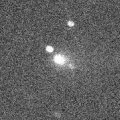
|
Brightening more rapidly than expected, and coming closer to the earth. It passes near by earth in October. Now it is visible visually at 14.5 mag (Sept. 28, Bob King). However, it will fade out rapidly in November, and will be fainter than 18 mag in late December.
Date(TT) R.A. (2000) Decl. Delta r Elong. m1 Best Time(A, h)
Oct. 11 2 36.94 9 30.0 0.409 1.385 157 15.1 1:18 (180, 46)
Oct. 18 2 42.05 10 32.5 0.399 1.382 162 15.0 0:56 (180, 44)
|
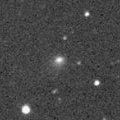
|
Now it is 15.3 mag (Sept. 7, Ken-ichi Kadota). It will be observable at 15 mag in good condition in next autumn. It is also observed visually at 14.3 mag (Sept. 28, Alan Hale).
Date(TT) R.A. (2000) Decl. Delta r Elong. m1 Best Time(A, h)
Oct. 11 2 29.91 23 17.8 2.459 3.385 154 15.0 1:12 (180, 32)
Oct. 18 2 9.28 22 37.3 2.428 3.397 164 15.0 0:24 (180, 32)
|
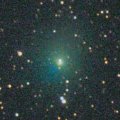
|
It reached up to 9.5 mag on Mar. 29 (Maik Meyer). Now it is fading slowly. It faded down to 10.7 mag on May 11 (Marco Goiato), and it was a diffuse object with a weak condensation. In the Northern Hemisphere, it will never be observable again. In the Southern Hemisphere, it keeps observable until it fades out. No observations have been reported recently, and the current brightness is uncertain.
Date(TT) R.A. (2000) Decl. Delta r Elong. m1 Best Time(A, h)
Oct. 11 12 31.72 -56 25.6 3.295 2.759 49 15.3 3:55 (326, 19)
Oct. 18 12 52.31 -58 11.7 3.384 2.834 49 15.5 3:45 (328, 20)
|
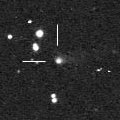
|
Now it is 14.7 mag (Oct. 1, Juan Jose Gonzalez), already visible visually. It will be brightening gradually after this, and reach to 12-13 mag in 2009 winter and spring. In the Northern Hemisphere, it keeps observable for a long time until 2009 May.
Date(TT) R.A. (2000) Decl. Delta r Elong. m1 Best Time(A, h)
Oct. 11 20 43.68 -27 50.7 1.474 2.016 107 15.4 19:38 (154, 82)
Oct. 18 20 46.49 -27 7.9 1.500 1.962 101 15.3 19:45 (125, 77)
|

|
Now it is 14.3 mag, and visible visually (Oct. 9, Juan Jose Gonzalez). It locates near by Polaris until December, and observable all night. It will brighten gradually after this, and reach to 9-10 mag in 2009 June. In the Northern Hemisphere, it keeps observable in good condition until May when it becomes brightest. But it will never be observable again after that. In the Southern Hemisphere, it is not observable until 2009 April. But after that, it will be observable while fading gradually.
Date(TT) R.A. (2000) Decl. Delta r Elong. m1 Best Time(A, h)
Oct. 11 7 37.52 81 20.0 3.283 3.526 95 15.6 3:55 (186,-28)
Oct. 18 8 0.62 82 15.4 3.160 3.453 98 15.4 3:45 (185,-29)
|
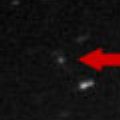
|
Now it is 15.6 mag (Sept. 18, Siding Spring Survey). It will be getting lower in the evening sky, and it will be unobservable in December.
Date(TT) R.A. (2000) Decl. Delta r Elong. m1 Best Time(A, h)
Oct. 11 16 59.33 -13 27.7 2.394 2.042 57 15.7 19:38 ( 96, 32)
Oct. 18 17 13.70 -14 9.8 2.419 2.008 54 15.6 19:45 ( 92, 28)
|
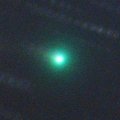
|
It brightened up to 9.2 mag on July 15 (Juan Jose Gonzalez). It was bright as 10.9 mag still on Aug. 9 (Juan Jose Gonzalez). However, it is fading rapidly after mid August. It is already invisible visually, fainter than 13.1 mag (Sept. 9, Seiichi Yoshida). It has already faded down to 14.9 mag on Sept. 9 by CCD (Ken-ichi Kadota). However, the location will be better after this. It keeps observable by CCD until it fades out in winter.
Date(TT) R.A. (2000) Decl. Delta r Elong. m1 Best Time(A, h)
Oct. 11 8 48.77 24 32.6 1.837 1.768 70 15.7 3:55 (228, 12)
Oct. 18 8 58.80 24 14.0 1.825 1.834 74 16.1 3:45 (227, 13)
|
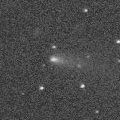
|
Now it is 15.4 mag (Sept. 5, S. Sanchez et al.). It will be fading slowly after this. But it keeps observable in good condition until February when it becomes fainter than 18 mag.
Date(TT) R.A. (2000) Decl. Delta r Elong. m1 Best Time(A, h)
Oct. 11 3 35.31 10 36.3 1.241 2.125 143 15.7 2:17 (180, 44)
Oct. 18 3 33.99 9 59.6 1.211 2.133 149 15.7 1:48 (180, 45)
|

|
Now it is 17.2 mag (Sept. 10, Ken-ichi Kadota). It will brighten rapidly after this. It will be observable at 12-13 mag for a long time from January to July in 2009.
Date(TT) R.A. (2000) Decl. Delta r Elong. m1 Best Time(A, h)
Oct. 11 8 55.95 20 48.2 3.089 2.858 67 15.9 3:55 (232, 13)
Oct. 18 9 5.17 20 16.0 2.975 2.832 72 15.8 3:45 (231, 15)
|
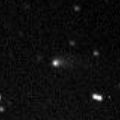
|
Now it is 15.6 mag (Aug. 7, Ken-ichi Kadota). It locates somewhat low in the Northern Hemisphere, but it keeps observable around 16 mag until winter. It is also observed visually at 14.6 mag (Aug. 6, Juan Jose Gonzalez).
Date(TT) R.A. (2000) Decl. Delta r Elong. m1 Best Time(A, h)
Oct. 11 20 56.85 -25 17.7 2.356 2.874 111 15.8 19:38 (177, 80)
Oct. 18 20 59.66 -24 25.5 2.435 2.865 105 15.8 19:45 (142, 77)
|

|
Not recovered yet. It is predicted to be already brightening up to 16 mag. It will reach up to 16 mag until November, and will be observable in good condition. But actually, it may be much fainter than expected. It keeps observable in the morning sky until January when it will be fainter than 18 mag.
Date(TT) R.A. (2000) Decl. Delta r Elong. m1 Best Time(A, h)
Oct. 11 9 1.85 7 48.4 0.980 1.029 62 16.1 3:55 (243, 22)
Oct. 18 9 38.26 4 27.7 0.990 0.992 59 15.9 3:45 (249, 20)
|
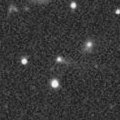
|
Now it is 16.4 mag (Aug. 31, J. A. Henriquez). Brightened rapidly, and it still keeps brightening even after passing the perihelion. It will be observable at 16 mag in good condition until November. It is also observed visually at 14.8 mag (Sept. 29, Juan Jose Gonzalez).
Date(TT) R.A. (2000) Decl. Delta r Elong. m1 Best Time(A, h)
Oct. 11 0 55.14 21 54.0 1.387 2.365 164 16.0 23:33 (180, 33)
Oct. 18 0 53.10 19 46.4 1.398 2.378 166 16.0 23:03 (180, 35)
|
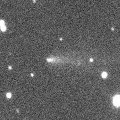
|
Now it is 15.2 mag (Aug. 2, Ken-ichi Kadota). Now it is brightest, and it will be fading after this. It keeps observable in good condition until it fades out in winter. The position is very different from the original prediction. It is also observed visually at 14.0 mag (Sept. 7, Juan Jose Gonzalez).
Date(TT) R.A. (2000) Decl. Delta r Elong. m1 Best Time(A, h)
Oct. 11 4 54.18 17 45.6 1.275 2.007 123 16.1 3:35 (180, 37)
Oct. 18 4 54.11 17 55.8 1.249 2.041 130 16.3 3:08 (180, 37)
|
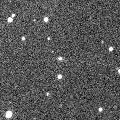
|
Getting higher gradually in the morning sky. It will be observable at 15 mag in good condition in winter.
Date(TT) R.A. (2000) Decl. Delta r Elong. m1 Best Time(A, h)
Oct. 11 9 8.82 20 43.4 4.014 3.696 64 16.4 3:55 (234, 11)
Oct. 18 9 15.56 20 25.4 3.913 3.690 69 16.3 3:45 (233, 13)
|
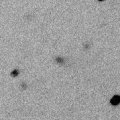
|
Now it is 17.5 mag (Sept. 13, A. Sanchez). It will be observable at 16 mag in good condition from autumn to winter.
Date(TT) R.A. (2000) Decl. Delta r Elong. m1 Best Time(A, h)
Oct. 11 2 31.17 29 57.2 1.697 2.608 149 16.5 1:13 (180, 25)
Oct. 18 2 27.13 30 4.8 1.645 2.586 155 16.3 0:41 (180, 25)
|

|
Not recovered yet, but it must be brightening very rapidly in the evening sky. It is expected to reach up to 7.5 mag in January. However, it is not observable for about a month around the highlight. In the Northern Hemisphere, it keeps locating low in the evening sky until the highlight. But it turns to appear in the morning sky after February, then it keeps observable in good condition while fading gradually. In the Southern Hemisphere, it locates high except for January.
Date(TT) R.A. (2000) Decl. Delta r Elong. m1 Best Time(A, h)
Oct. 11 18 59.01 -31 34.3 1.394 1.639 84 16.9 19:38 ( 89, 65)
Oct. 18 19 2.97 -31 20.4 1.396 1.550 78 16.6 19:45 ( 86, 58)
|
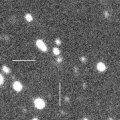
|
It will be observable at 16.5-17 mag in good condition in autumn. It will be fainter than 18 mag in February.
Date(TT) R.A. (2000) Decl. Delta r Elong. m1 Best Time(A, h)
Oct. 11 18 48.27 21 13.4 1.730 1.973 88 16.8 19:38 (146, 26)
Oct. 18 18 57.50 21 36.9 1.759 1.954 85 16.8 19:45 (141, 22)
|

|
Now it is 17.8 mag (Aug. 3, Ken-ichi Kadota). It will brighten up to 12 mag in 2012. It is faint still in 2008, but observable at 17 mag in good condition.
Date(TT) R.A. (2000) Decl. Delta r Elong. m1 Best Time(A, h)
Oct. 11 22 51.95 5 19.4 9.463 10.311 146 17.0 21:30 (180, 50)
Oct. 18 22 48.98 4 57.5 9.497 10.273 139 17.0 20:59 (180, 50)
|

|
It had been lost since its discovery in 1892, but finally recovered. It passes extremely near by the earth in October, and will reach to 17 mag. However, because it is a very tiny comet, it will fade out very soon. It will be fainter than 18 mag in mid November, and fainter than 20 mag in mid Decemeber. In addition, it moves southwards very fast.
Date(TT) R.A. (2000) Decl. Delta r Elong. m1 Best Time(A, h)
Oct. 11 22 0.83 29 40.2 0.227 1.160 131 17.4 20:42 (180, 26)
Oct. 18 22 41.71 12 28.6 0.195 1.149 138 17.1 20:55 (180, 44)
|
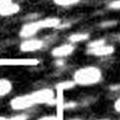
|
It was observed at 16.5-17 mag in 2007 autumn. Now it is 17.3 mag (July 2, J. F. Hernandez). It will be observable at 17 mag for a long time from summer to autumn.
Date(TT) R.A. (2000) Decl. Delta r Elong. m1 Best Time(A, h)
Oct. 11 5 11.14 28 31.5 2.096 2.718 118 17.1 3:52 (180, 26)
Oct. 18 5 10.81 28 33.6 2.046 2.747 125 17.1 3:24 (180, 26)
|
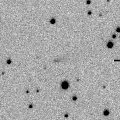
|
It was bright as 16.5 mag on Aug. 31 (Michael Jager). But it has alraedy faded down to 17.5 mag (Oct. 5, C. Rinner, F. Kugel). It will be fainter than 18 mag in December.
Date(TT) R.A. (2000) Decl. Delta r Elong. m1 Best Time(A, h)
Oct. 11 9 44.31 19 33.4 1.858 1.547 56 17.2 3:55 (241, 6)
Oct. 18 10 1.65 18 22.1 1.849 1.586 58 17.3 3:45 (242, 7)
|
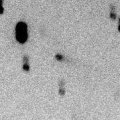
|
It is observable at 17.5 mag in good condition in autumn. It will be fainter than 18 mag in December.
Date(TT) R.A. (2000) Decl. Delta r Elong. m1 Best Time(A, h)
Oct. 11 1 45.00 27 12.7 0.770 1.736 157 17.3 0:27 (180, 28)
Oct. 18 1 41.64 27 47.7 0.755 1.729 161 17.3 23:51 (180, 27)
|
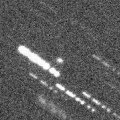
|
It keeps 17.5-18 mag for a long time until early summer in 2009. It becomes low in December, but it is observable in good condition except for that time.
Date(TT) R.A. (2000) Decl. Delta r Elong. m1 Best Time(A, h)
Oct. 11 17 29.51 34 3.5 3.177 3.065 74 17.4 19:38 (139, 5)
Oct. 18 17 26.58 32 5.8 3.245 3.047 69 17.4 19:45 (131, 1)
|

|
It reached up to 16 mag last winter. Now it is fading, but it will be observable at 17.5 mag in good condition from autumn to winter.
Date(TT) R.A. (2000) Decl. Delta r Elong. m1 Best Time(A, h)
Oct. 11 5 3.93 16 15.0 5.112 5.694 121 17.6 3:45 (180, 39)
Oct. 18 5 1.88 16 39.8 5.053 5.727 128 17.6 3:16 (180, 38)
|
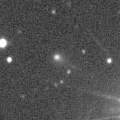
|
It was observed as bright as 14-15 mag in 2007 autumn. It will be observable at 17.5 mag in good condition from autumn to winter in 2008.
Date(TT) R.A. (2000) Decl. Delta r Elong. m1 Best Time(A, h)
Oct. 11 8 4.91 30 59.0 3.219 3.222 81 17.7 3:55 (217, 13)
Oct. 18 8 10.96 30 59.4 3.147 3.247 86 17.7 3:45 (215, 14)
|
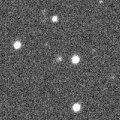
|
It will brighten up to 15 mag in 2009 and 2010. In this autumn, it is observable at 17.5 mag in good condition.
Date(TT) R.A. (2000) Decl. Delta r Elong. m1 Best Time(A, h)
Oct. 11 21 50.21 16 54.3 3.693 4.415 131 17.8 20:28 (180, 38)
Oct. 18 21 42.42 16 24.8 3.732 4.366 123 17.8 19:53 (180, 39)
|
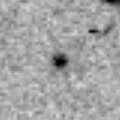
|
Now it is 18.1 mag (Sept. 29, S. Gajdos). It was origibally expected to reach up to 10 mag in winter based on the brightness at the discovery. However, it is actually much fainter than expected, and will be only 16 mag at best. It keeps observable in good condition for a long time until next spring.
Date(TT) R.A. (2000) Decl. Delta r Elong. m1 Best Time(A, h)
Oct. 11 3 27.28 22 50.1 0.964 1.859 142 18.1 2:08 (180, 32)
Oct. 18 3 29.48 22 47.5 0.886 1.814 149 17.8 1:43 (180, 32)
|

|
It will be observable at 18 mag in good condition from autumn to winter.
Date(TT) R.A. (2000) Decl. Delta r Elong. m1 Best Time(A, h)
Oct. 11 9 37.95 29 43.7 2.555 2.265 62 17.9 3:55 (232, 0)
Oct. 18 9 52.55 29 37.1 2.501 2.281 65 17.9 3:45 (232, 1)
|
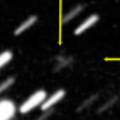
|
It was predicted to be so bright as 14 mag from spring to summer in 2008. But actually, it was extremely faint as 19.5 mag (Aug. 4, Gustavo Muler). Although it locates in good condition, it will be hard to observe.
Date(TT) R.A. (2000) Decl. Delta r Elong. m1 Best Time(A, h)
Oct. 11 22 3.26 12 28.0 2.075 2.866 134 20.3 20:42 (180, 43)
Oct. 18 22 5.34 11 49.9 2.186 2.920 129 20.5 20:16 (180, 43)
|
|
![]()
 19P/Borrelly
19P/Borrelly 7P/Pons-Winnecke
7P/Pons-Winnecke C/2007 W1 ( Boattini )
C/2007 W1 ( Boattini ) C/2007 G1 ( LINEAR )
C/2007 G1 ( LINEAR ) C/2008 J1 ( Boattini )
C/2008 J1 ( Boattini ) C/2006 Q1 ( McNaught )
C/2006 Q1 ( McNaught ) 205P/2008 R6 ( Giacobini )
205P/2008 R6 ( Giacobini ) 29P/Schwassmann-Wachmann 1
29P/Schwassmann-Wachmann 1 C/2007 Q3 ( Siding Spring )
C/2007 Q3 ( Siding Spring ) C/2007 B2 ( Skiff )
C/2007 B2 ( Skiff ) C/2005 L3 ( McNaught )
C/2005 L3 ( McNaught ) C/2006 U6 ( Spacewatch )
C/2006 U6 ( Spacewatch ) P/2008 Q2 ( Ory )
P/2008 Q2 ( Ory ) C/2007 U1 ( LINEAR )
C/2007 U1 ( LINEAR ) C/2008 C1 ( Chen-Gao )
C/2008 C1 ( Chen-Gao ) 67P/Churyumov-Gerasimenko
67P/Churyumov-Gerasimenko C/2008 T2 ( Cardinal )
C/2008 T2 ( Cardinal ) 68P/Klemola
68P/Klemola 15P/Finlay
15P/Finlay 61P/Shajn-Schaldach
61P/Shajn-Schaldach 116P/Wild 4
116P/Wild 4 47P/Ashbrook-Jackson
47P/Ashbrook-Jackson P/2001 J1 ( NEAT )
P/2001 J1 ( NEAT ) P/2008 L2 ( Hill )
P/2008 L2 ( Hill ) 51P/Harrington
51P/Harrington 74P/Smirnova-Chernykh
74P/Smirnova-Chernykh 59P/Kearns-Kwee
59P/Kearns-Kwee P/2003 K2 ( Christensen )
P/2003 K2 ( Christensen ) C/2008 R3 ( LINEAR )
C/2008 R3 ( LINEAR ) C/2006 S3 ( LONEOS )
C/2006 S3 ( LONEOS ) 206P/2008 T3 ( Barnard-Boattini )
206P/2008 T3 ( Barnard-Boattini ) 44P/Reinmuth 2
44P/Reinmuth 2 201P/2008 Q4 ( LONEOS )
201P/2008 Q4 ( LONEOS ) P/2008 QP20 ( LINEAR-Hill )
P/2008 QP20 ( LINEAR-Hill ) C/2008 Q1 ( Maticic )
C/2008 Q1 ( Maticic ) C/2006 K1 ( McNaught )
C/2006 K1 ( McNaught ) 188P/2007 J7 ( LINEAR-Mueller )
188P/2007 J7 ( LINEAR-Mueller ) C/2008 N1 ( Holmes )
C/2008 N1 ( Holmes ) 144P/Kushida
144P/Kushida 33P/Daniel
33P/Daniel C/2007 K3 ( Siding Spring )
C/2007 K3 ( Siding Spring )![]()





































